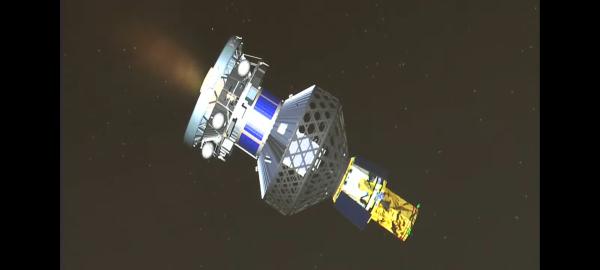PSLV successfully launched three Singapore satellites, Gaganyaan mission delays – ISRO Chairman.
- Karthik Naren
- Jun 30, 2022
- 4 min read
Updated: Jul 1, 2022
ISRO's PSLV-CA No. C53 rocket made the perfect launch.

Chennai, 30 June 2022; today at 12:32 UTC (18:02 EDT) launched a PSLV-CA C53 rocket from the Second Launch Pad at Satish Dhawan Space Centre, India, with three satellites and a hosted payload platform, the payloads deployed into the 533 × 567 km / Inclination 9.9° low earth orbit, and the launch mission is a complete success.
The satellites and payloads for this flight were:

DS-EO, 365kg: “Singapore Earth Observation Satrec Initiative” Electro
-optical observation satellite for ST Engineering and the Singapore Defense Science and Technology Agency.
The DS-EO carries a multispectral electro-optical payload with 0.5 m resolution imaging capability in low orbit.

NeuSAR 155kg: Singapore Earth Observation, Satrec Initiative radar; NeuSAR is Singapore's first small commercial satellite with a SAR payload, built by the Starec Initiative, designed to achieve a revisit time of fewer than 60 minutes for six satellites in the constellation, NeuSAR is also able to provide day and night, all-weather, and through-cloud imaging possibilities.

SCOOB-I (S3 1) : Singapore Technology's 3kg Cubesat 3U: The satellite is the first satellite in the Student Satellite Series (S3-I), a hands-on training program for students at the Satellite Research Center (SaRC) of the School of Electrical and Electronics Engineering at Nanyang Technological University (NTU).
POEM: On the PS4 stage, six hosted experiments with two payloads from Indian startups; Dhruva Space's DSOD 1U Cubesat and Digantara's ROBI
It is the first time that the PS4 stage would orbit the earth as a stabilized platform.
On the occasion of 'Azadi Ka Amrit Mahotsav', this time the rocket stage will carry the pledge of India and the national flag to commemorate the 75th Anniversary of India's Independence.

On the Post-launch Press conference, ISRO announced various updates on the future missions
Gaganyaan Update
ISRO Chairman S Somanath on Thursday's press meet said the launch of the ambitious Gaganyaan mission, the country's first manned space flight, cannot happen this year or next year as the agency is keen to ensure that all safety systems are in place.
Noting that it is a very important mission, the ISRO chief said a lot of focus would have to be on safety when humans are sent to space.
"It is a very high profile mission. We have to be extremely careful when we send humans to space," Somanath said at a press conference after the successful launch of three foreign satellites by ISRO at the spaceport here. He said tests were carried out with regard to safety. "We are testing it more number of times, We would like to do it very cautiously."
The ISRO chief emphasized that various demonstrations would be taken up and an unmanned mission in the middle of next year and make sure everything is fine. "(Gaganyaan) cannot happen this year or next year. This is for the safety of our folks." "We need to remove the worry part – any time it can burst. Worry can be removed only by ruggedizing the object, testing it more times, and introducing intelligence in the rocket so that it can identify problems, and let the aircraft know pilots can escape. But rockets cannot do that.
Rockets are moving very fast and rockets themselves have to find out something is going bad now so let these fellows go away. It will automatically command an escape system and the astronauts can escape. This is the new system, currently what we are doing is let us wait for some more time."
"If we want to fly astronauts, we need to first prove the safety system.. it has to go through many tests. We are trying to do that this year. I don't want to end up doing the Gaganyaan program with a disaster. We will want to do it very cautiously."
Chandrayaan-3 Update
Somanath said currently a lot of tests were going on and added that "this time we are not in a hurry to go to the moon."
"This time we want to make sure we land on the moon."
"Currently the tests on lander propulsion and lander systems are underway. We want to make it very rugged. We have made the lander rugged. So some mass increase in lander has occurred. Its legs have been made stronger.
The propulsion system needs to be rugged. Tests are going on at Mahendragiri for proving that. We want to look at the sensors. Last time we had doubts on sensors. So we are adding new sensors, helicopter sorties, and experiments. Let us complete all tests and be clear," he further said.
The Chandrayaan-3 mission is a follow-up of Chandrayaan-2, which was India's first mission to land on the lunar South Pole. However, the lander Vikram hard-landed in September 2019. Asked if there were plans to make the PS-IV stage a routine experiment after in-orbit scientific experiments were carried out, Somanath said, "normally the 4th stage would end up as debris in space. But, ISRO has repurposed the fourth stage and introduced a computer, control system to fire its thrusters, sensors such as star sensors that will enable it look at the stars and find its own position and also send commands from the ground."
GSLV commercial launch and second spaceport
GSLV is currently booked for our own internal launches. "So we are not offering GSLV-Mk II for commercial launches for the time being. Mk-III we have already announced for launch for commercial launches. Next mission will be a commercial mission. That will carry very well-known OneWeb satellites, mid Sept-Oct this year and next year by January 2023."
On the spaceport expected to come up at Kulasekarapattinam, Somanath said, "2,000 acres has come to ISRO's hands. Area, where we have to build the launch pad, is with us and the design process is complete. The tendering process has started."













Comments